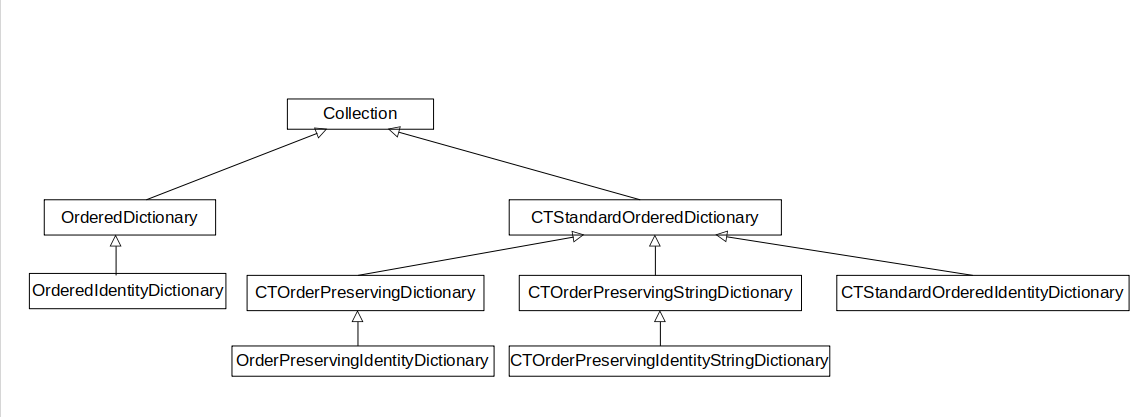Comparing Ordered Dictionaries
During second week of GSoC 2019 coding period on Pharo project, I was learning more about existing implementations of Ordered dictionaries, comparing them and polishing Containers-OrderPreservingDictionary a little bit.
I couldn’t help but notice all the similarities between Collections - OrderedDictionary and Containers-OrderPreservingDictionary. They both start from the same place, inheriting from Collections. The diagram below shows inheritance relationships:

All of these classes: OrderedDictionary, CTStandardOrderedDictionary and CTOrderPreservingDictionary had dictionaries that are keeping their key-value pairs in some sort of an order. I wanted to know what are the differences between these orders. Let’s see:
- OrderedDictionary
| orderedDict |
orderedDict := OrderedDictionary new.
orderedDict at: 1 put: 'first'.
orderedDict at: 2 put: 'second'.
orderedDict at: 1 put: 'another first'.
orderedDict >>> 'an OrderedDictionary(1->''another first'' 2->''second'')'
- CTSTandardOrderedDictionary
| standardOrederedDict |
standardOrederedDict := CTStandardOrderedDictionary new.
standardOrederedDict at: 1 put: 'first'.
standardOrederedDict at: 2 put: 'second'.
standardOrederedDict at: 1 put: 'another first'.
standardOrederedDict >>> 'a CTStandardOrderedDictionary(1->''another first'' 2->''second'')'
- CTOrderPreservingDictionary
| orderPreservingDict |
orderPreservingDict := CTOrderPreservingDictionary new.
orderPreservingDict at: 1 put: 'first'.
orderPreservingDict at: 2 put: 'second'.
orderPreservingDict at: 1 put: 'another first'.
orderPreservingDict >>> 'a CTOrderPreservingDictionary(1->''another first'' 2->''second'')'
The order is preserved in all three classes in the same way.
If the order is same, what could be the other differences between all these classes from the diagram?
I decided to compare these pairs:
- OrderedDictionary vs CTStandardOrderedDictionary
- CTStandardOrderedDictionary vs CTOrderPreservingDictionary
- OrderedIdentityDictionary vs CTStandardOrderedIdentityDictionary
- CTOrderPreservingIdentityDictionary vs CTStandardOrderedIdentityDictionary
- CTOrderPreservingDictionary vs CTOrderPreservingStringDictionary
1. OrderedDictionary vs CTStandardOrderedDictionary
Both of these classes are subclass of Collections. Majority of their methods are completely the same. There are some differences though:
-
OrderedDictionary has methods that CTSODictionary doesn’t like:
- asValueHolder:
- at:at:
- at:at:ifAbsent:
- at:at:put:
- at:ifPresent:ifAbsentPut:
- atRandom:
- bindingOf;
- bindingsDo:
- declareFrom:
- gtInspectorItemsIn:
- hasBindingThatBeginsWith:
- isHealthy
- removeUnreferencedKeys
- stonOn:
- storeOn:
- unreferencedKeys
and on the class side:
- inspectorClass
- newFromKeysandValues:
-
CTStandardOrderedDictionary has methods that aren’t in OrderedDictionary:
- speciesNewFrom:
- orderedKeysIdentityIndexOf:
- copyEmpty:
- errorValueNotFound:
- isEmpty
- isIdentityDictionary
- isOrderPreservingDictionary
- orderedKeysIdentityIndexOf:
All these methods are written keeping in mind portability to Squeak and GS
-
There are methods which has the same name and the same functionality only
ifAbsent: was favored in CTSODictionary instead ofifPresent:again for portability purposes for Squeak and GS:
OrderedDictionary >> associationAt: aKey ifPresent: aBlock
^ dictionary associationAt: aKey ifPresent: aBlock
CTStandardOrderedDictionary >> associationAt: aKey ifPresent: aBlock
"Squeak and GS do not have #associationAt:ifPresent: so it
is reimplemented for portability"
^ aBlock cull:
(dictionary
associationAt: aKey
ifAbsent: [^ nil])
- all the core functionalities like adding, removing and similar are completely the same.
- both raise a
KeyNotFounderror when absent keys/values are accessed.
2. CTStandardOrderedDictionary vs CTOrderPreservingDictionary
We saw that the order is preserved in the same manner in both of these classes.
The difference: By default, when CTStandardOrderedDictionary raises an exception and CTOrderPreservingDictionary returns a configurable default value (nil by default) instead of raising an exception.
- CTStandardOrderedDictionary
| dict |
dict := CTStandardOrderedDictionary new.
dict at: #missing
>>> 'KeyNotFound'
- CTOrderPreservingDictionary
| dict |
dict := CTOrderPreservingDictionary new.
dict defaultValue: 666.
dict at: #missing
>>> 666
In conclusion several methods in CTOrderPreservingDictionary are overriden so that they return a default value.
(OrderedDictionary like CTStandardOrderedDictionary raises an error)
3. OrderedIdentityDictionary vs CTStandardOrderedIdentityDictionary
All identity dictionaries have the feature of using == instead of = for key comparing.
- CTStandardOrderedIdentityDictionary has one extra method that OrderedIdentityDictionary doesn’t have:
isIdentityDictionary
^ true
- All other methods are completely the same
4. CTOrderPreservingIdentityDictionary vs CTStandardOrderedIdentityDictionary
- all the methods are completely the same. The only difference is what
selfrefers to which means CTOrderPreservingID has default values and CStandardOrderedID raises erros.
5. CTOrderPreservingDictionary vs CTOrderPreservingStringDictionary
What I expected from CTOrderPreservingStringDictionary based on its name was that they key values could only be Strings. That didn’t make much sense and when I checked it didn’t behave like that:
| strDict |
strDict := CTOrderPreservingStringDictionary new.
strDict at: 1 put: 10.
strDict at: 2 put: 20.
strDict >>> 'a CTOrderPreservingStringDictionary(1->10 2->20)'
So you can use other data types besides Strings for both keys and values. Then why String in the name of the class?
- default values is set to ` ‘ ‘ `(empty string)
CTOrderPreservingDictionary >> at: aKey
^ self
at: aKey
ifAbsent: [defaultValue]
at: aKey
^ self
at: aKey
ifAbsent: ['']
-
CTOrderPresevingDicitonary has a few instance methods that CTOrderPreservingStringDict doesn’t:
-
copyEmpty:
-
defaultValue:
-
-
different class methods in CTOrderPresevingDicitonary :
- defaultValue:
- newWithDefaultValue:
- newFrom:
Conclusion:
There are a lot of code repetitions in these classes and subclass behavior differences are not that big. One of the solutions that is being discussed with mentors is merging some classes and using strategy.